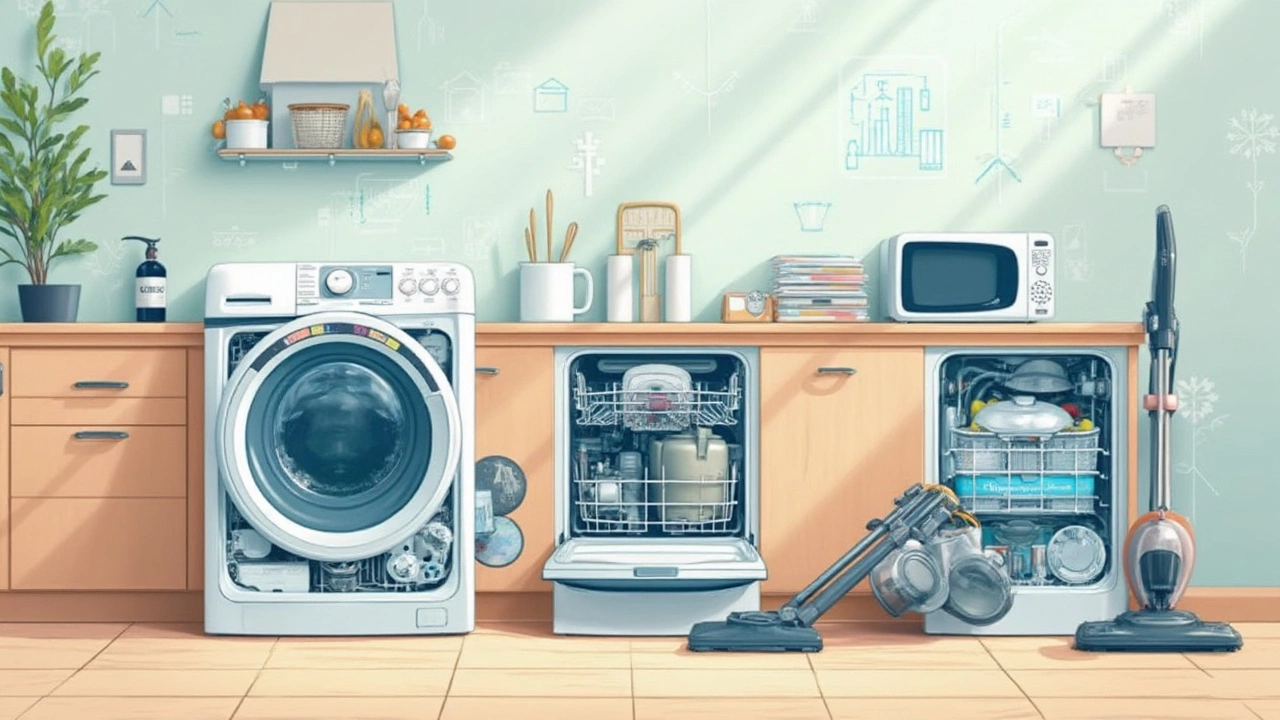If someone asked you, "What’s an appliance?" you might point straight at your fridge, and you’d be spot on. An appliance is a device that does physical tasks for you—think washing, cooling, cooking—or helps keep your home comfortable. They're not just for kitchens, either. Basically, if you plug it in or hook it up and it handles a chore, you’re probably looking at an appliance.
Take the washing machine as a classic example. It's one of those behind-the-scenes heroes. Without it, laundry piles would eat your weekend alive. It’s a perfect illustration: an appliance that saves time, keeps clothes clean, and blends into your day so much, you barely notice it until it breaks (which, if you’ve had to fix one on short notice, you know feels like the world’s ending for a day or two).
- Breaking Down 'Appliance'
- Everyday Appliance Examples
- How Appliances Make Life Easier
- Smart Care and Maintenance Tips
Breaking Down 'Appliance'
So, what actually counts as an appliance? In simple terms, it’s a machine or tool that takes care of a household job—like chilling your groceries, washing clothes, or cooking dinner. These gadgets run on electricity, gas, or water, and usually live in the places where you spend a lot of home time: the kitchen, laundry room, or even the bathroom (think: electric toothbrushes).
To keep it clear, here’s how experts sort them out:
- Major appliances (sometimes called white goods): These are your heavy-hitters—fridge, dishwasher, oven, washing machine, dryer. They're big, do the hard work, and if they break, you notice fast.
- Small appliances: Toasters, kettles, blenders, coffee makers. They’re light, easy to move, and usually sit on your countertop.
One easy way to spot an appliance is to ask, “Does it make daily life easier by doing a specific job, and does it need power?” If both answers are yes, it’s probably an appliance.
Homeowners in the U.S. have, on average, over a dozen appliances running daily. Here’s a quick look at energy use for common ones:
| Appliance | Avg. Energy Use (kWh/year) |
|---|---|
| Refrigerator | 600 |
| Washing Machine | 150 |
| Dishwasher | 180 |
| Microwave | 215 |
| Clothes Dryer | 900 |
That’s a lot of power, which is why knowing a bit about your appliances—and how they work—can save you money and headaches down the line.
Everyday Appliance Examples
When you think of a home appliance, a few classics probably jump right out. Let’s get super clear and talk about the ones you almost can’t live without these days. If you walked into any house, you’d spot at least one of these within seconds.
- Refrigerator: Maybe the OG kitchen hero. It keeps your food safe and cold day in, day out. Compare that to just 100 years ago—back then, people had to use iceboxes or salt. The modern fridge is a total game changer.
- Washing Machine: No more beating clothes on rocks or heading out to laundromats every week. The washing machine takes care of mountains of dirty laundry, even in houses with several kids like mine.
- Microwave: This one’s all about convenience and speed. Pop your food in, hit a couple of buttons, and you’ve got a hot meal ready in minutes. The average microwave cuts down cooking time by up to 80% compared to the oven.
- Dishwasher: Hate doing dishes by hand? You’re not alone. The dishwasher saves hundreds of hours a year, especially for big families.
- Oven and Stove: From pizza Fridays to Sunday roasts, these appliances are at the heart of home-cooked comfort food. Gas or electric, they’re the workhorses in the kitchen.
- Vacuum Cleaner: Keeps carpets and floors clean, making quick work of whatever the kids or your pets drag in.
Let’s put some numbers to it. Here’s a peek at how common these appliances are in U.S. homes:
| Appliance | % of Homes (2024) |
|---|---|
| Refrigerator | 99% |
| Washing Machine | 91% |
| Microwave | 94% |
| Dishwasher | 80% |
| Vacuum Cleaner | 94% |
Don’t forget some newer appliances that are starting to show up everywhere—like smart thermostats, robot vacuums, and air fryers. These aren’t just for show; they actually make life smoother, especially when you’re juggling kids and a million things at once. The key takeaway? Appliances are the machines we count on every day to make life at home way less stressful.

How Appliances Make Life Easier
The biggest perk of any appliance is that it slices chores down to size. Think about how much time you’d lose without a dishwasher or a clothes dryer. You’d be scrubbing plates after every meal and hanging socks all over your backyard just to get the basics done.
Here’s a quick look at where appliance power shines every day:
- Washing Machines: The average family does about 8 loads of laundry a week. Without one of these, you’d be hustling with a washboard or making endless trips to the laundromat.
- Refrigerators: Food used to spoil fast. The fridge lets you buy in bulk, keep leftovers fresh, and skip daily market runs.
- Microwaves: Got hungry kids? The microwave lets you throw together meals and snacks in minutes, not hours.
- Vacuum Cleaners: Imagine sweeping up after two dogs and a kid like Finn every day. Vacuums knock the job out in minutes and help people with allergies breathe easier.
One survey found that 90% of people say their kitchen appliances are essential for daily life, and over 60% have repaired an appliance rather than replace it, just to keep their routines smooth. These machines are built to save both effort and money. For example, modern Energy Star appliances use up to 50% less water and 30% less power than older models.
| Appliance | Time Saved per Week |
|---|---|
| Dishwasher | 6 hours |
| Washing Machine | 5 hours |
| Microwave | 3 hours |
Saving all that time means you get to do more things you actually enjoy—or, you know, just relax for a minute.
Smart Care and Maintenance Tips
Want your appliance to last longer and work better? Stay on top of some simple maintenance, and you’ll dodge a lot of headaches. Most breakdowns happen from plain neglect. If you know what to look for, you can fix small problems before they turn serious (and pricey).
First, always read the manual—yeah, the thing everyone ignores. Manufacturers actually give solid advice, like how often to clean filters or what type of detergent to use in your washing machine. Tailoring care to your specific appliance can double its lifespan.
- Washing machines: Wipe down rubber seals after each use to prevent mold. And run an empty hot wash with vinegar once a month to zap any weird smells.
- Fridges: Check the seals on the door. If they’re loose, your fridge wastes energy. Vacuum behind it every six months so dust doesn’t suffocate the coils.
- Microwaves: If you want it to smell less like old pizza, clean up spills right away. Placing a cup of water with lemon in the oven and microwaving it for a few minutes makes wiping grime off a breeze.
- Dryers: Clear out the lint trap after every cycle—seriously, every time. Built-up lint is the #1 cause of dryer fires. Also, check that the vent hose isn’t kinked or clogged.
Looking at the numbers, did you know that regular lint cleaning can improve your dryer’s efficiency by up to 25%? Here’s a quick breakdown of simple maintenance versus repair costs:
| Task | Time Spent | Avg. Savings (per year) |
|---|---|---|
| Clean refrigerator coils | 15 min | $35 on power bills |
| Change washing machine hoses | 10 min | $150+ (avoid water damage) |
| Clear dryer lint trap/vent | 5 min | $70 & fire safety |
Bottom line: a few minutes here and there using these appliance service tips keeps your home running smoothly and avoids nasty surprises. Put reminders on your calendar and treat your household machines to routine TLC—your future self will thank you, trust me.





